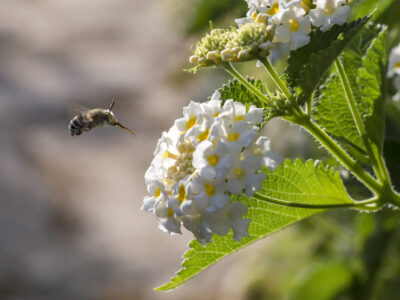Woodlands, beaches, hills, rivers, wetlands, and lakes are all part of the landscape of Wisconsin in the United States. With all of these habitats, it’s no wonder there are close to 700 species of wildlife living in this northern-central state. Some of the most well-known animals in Wisconsin include white-tailed deer, red fox, moose, wolves, black bear, robins, and, of course, badgers.
Official Animal
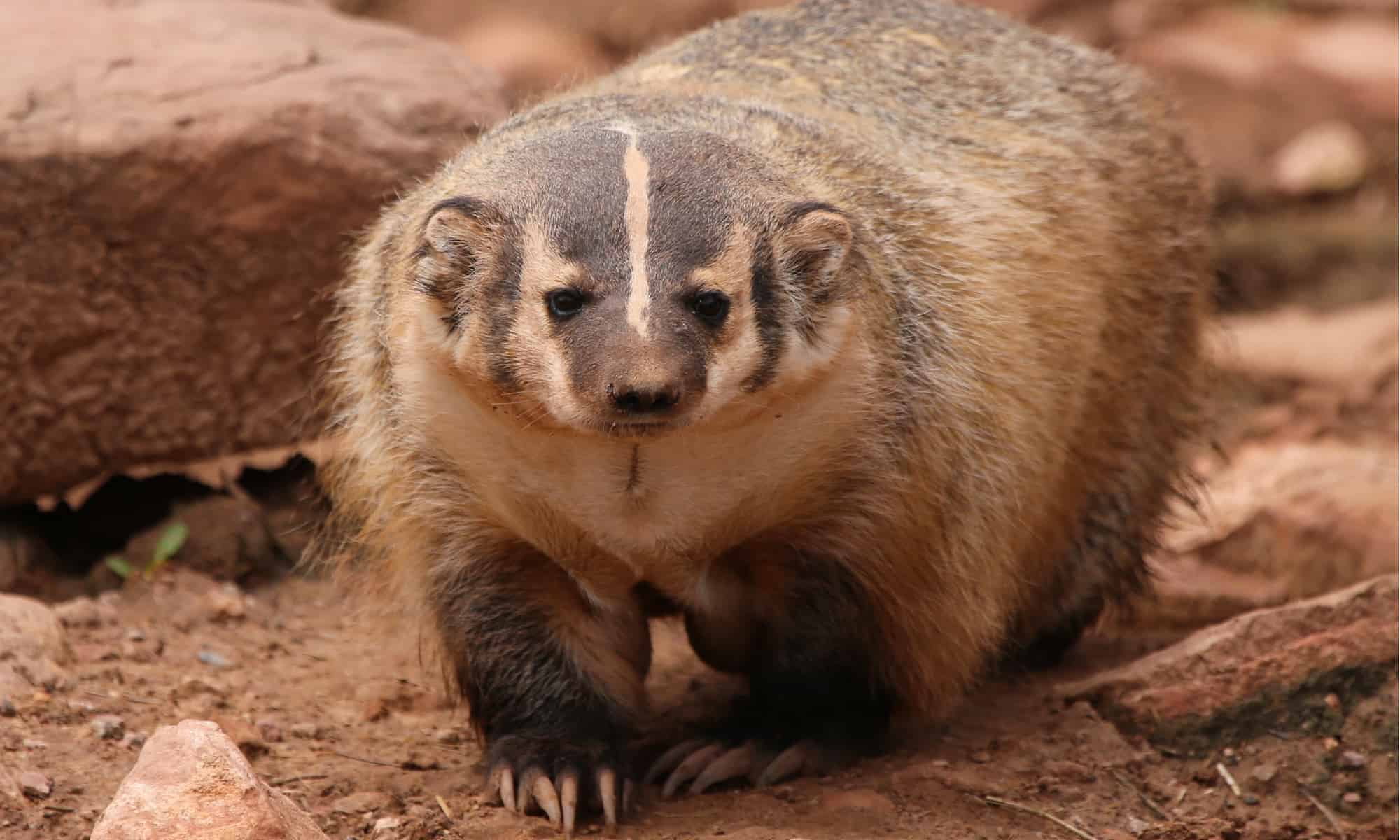
The American Badger is the official state animal for Wisconsin.
©Steve Boice/Shutterstock.com
In 1957, the American badger was made the official animal of the state of Wisconsin. Though this mammal is small, it can be very dangerous when it feels threatened. This native of Wisconsin has a strong body and powerful muscles in its neck along with sharp teeth. These wild animals are known for their furry black head featuring bright white stripes. The American badger has an IUCN status of Least Concern.
As a note, the white-tailed deer is known as the official wildlife animal of Wisconsin. Officials wanted to recognize this deer because it’s such a common sight around the state. Also, deer hunting plays an important part in the economy of Wisconsin.
Where to Find the Top Wild Animals
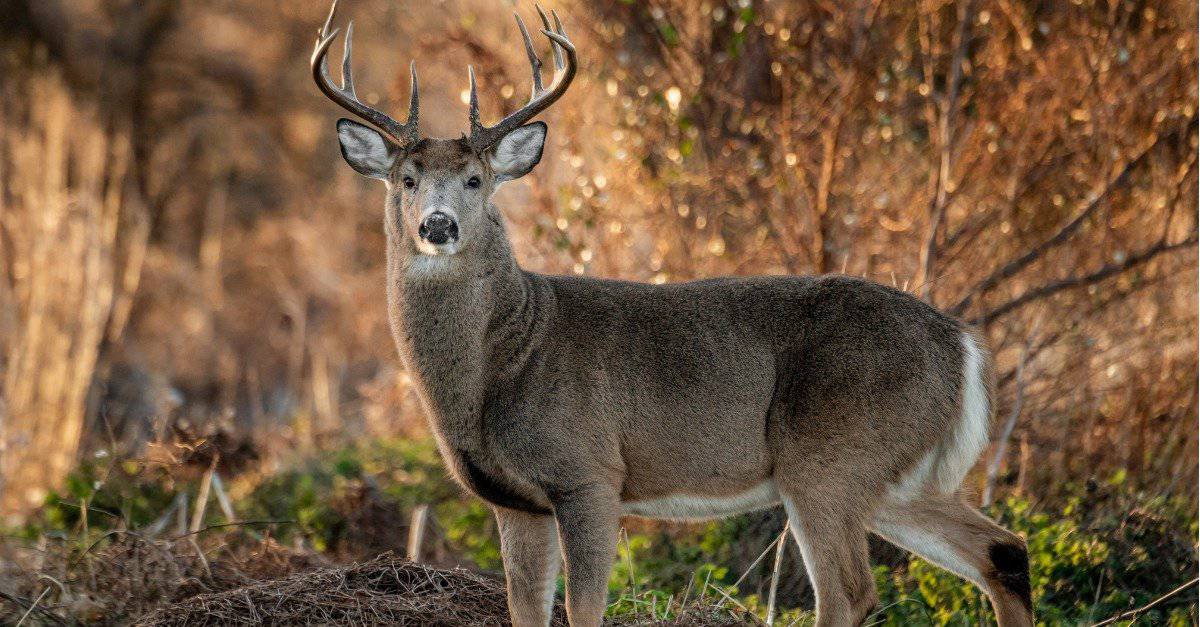
The white-tailed deer is commonly seen in Wisconsin and hunting season is important to the Wisconsin economy.
©iStock.com/Harry Collins
Wisconsin has a number of wildlife parks where visitors can see a variety of mammals, fish, birds, reptiles, and amphibians native to this northern central state.
The type of wildlife a visitor sees in Wisconsin depends on where they travel within the state. Traveling to the marshlands in Wisconsin gives visitors the chance to see red-backed salamanders, snapping turtles, mink frogs, American bullfrogs, five-lined skinks, river otters, beavers, American bitterns, and Sandhill cranes.
Checking out the woodland areas in the state gives visitors the opportunity to see countless mammals including red foxes, raccoons, white-tailed deer, striped skunks, gray squirrels, and cottontail rabbits. Birds including hawks, mallards, chestnut-sided warblers, pileated woodpeckers, and bobolinks can also be seen in the woodlands of this state. Painted Turtles are a common sight where Lake Michigan borders Wisconsin.
©Jonathan Novack/Shutterstock.com
Lake Michigan borders Wisconsin and is home to many types of wildlife. Visitors may see trout, bass, walleye, and catfish. Painted turtles are also a common sight. Mammals such as black bears, gray and red foxes, woodchucks, and squirrels can be seen near the shoreline as well. Mountain lions might be found in Wisconsin too.
Recommended locations for wildlife observation include:
- Wisconsin Deer Park – in the Wisconsin Dells, this park provides an opportunity to observe and feed over 100 deer and other wildlife in a hands-on, educational petting zoo.
- Buffalo Overlook – operated by the Oneida nation, the overlook offers an eye catching view of their buffalo herd from a covered observation deck.
- Trempealeau National Wildlife Refuge – established in 1936 along the eastern edge of the Mississippi River for the conservation, management and restoration of fish, wildlife, and plant resources and their habitats.
- Schlitz Audubon Nature Center – Milwaukee’s nature center with six miles of trails leading to 185 acres of forests, wetlands, restored prairies, ravines, bluffs, and Lake Michigan shoreline.
- Heckrodt Wetland Reserve – in Menasha, WI, this 91-acre urban nature reserve has forested wetland, cattail marsh, open water, created prairie, open field, and upland forest habitats.
- Bay Beach Wildlife Sanctuary – a 600-acre refuge in the Green Bay area and home to the second largest wildlife rehabilitation program in Wisconsin
Zoos
Visiting a zoo is another way to learn more about wildlife native to Wisconsin and some non-native to the state. Some zoos in the state include:
- Henry Vilas Zoo – opening in 1911, this is a free zoo dedicated to conservation.
- Milwaukee Zoo – focusing on animal management, conservation, research, and education
- Irvine Park and Zoo – in Chippewa Falls, WI
- Racine Zoo – in Racine, WI
- Lincoln Park Zoo – in Manitowoc, WI
- Menominee Park Zoo – in Oshkosh, WI
In addition, if looking for aquariums in Wisconsin, make sure to check out Discovery World in Milwaukee or the Beaver Springs Fishing Park in Wiscon Dells.
Most Dangerous
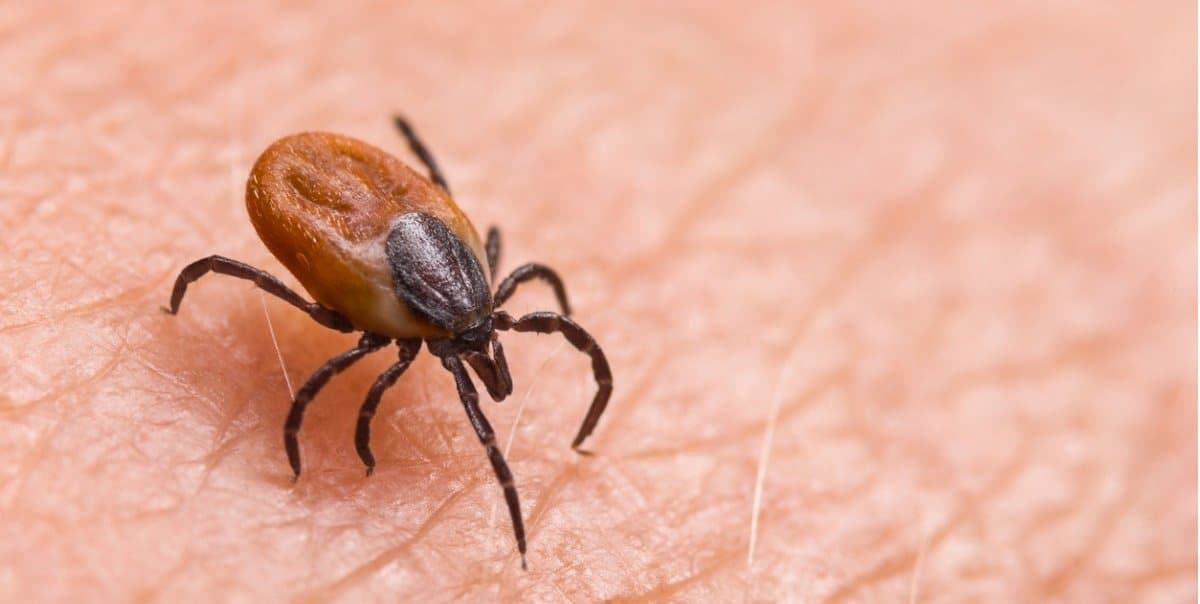
A Deer tick, a parasitic biting insect, can pass along Lyme disease, making it dangerous to humans.
©iStock.com/Ladislav Kubeš
Every state has some dangerous animals among their wildlife population and Wisconsin is no exception. Look at some of the most dangerous animals in the Badger state.
- The first animal on the most dangerous list is surprising. It’s the white-tailed deer (Odocoileus virginianus). These mammals definitely aren’t fierce, aggressive or poisonous. But, when they try to cross roadways they often end up running or jumping in front of vehicles. Unfortunately, these accidents can cause injuries or even death. According to the State of Wisconsin’s Department of Transportation, there were 18,414 accidents reported involving a vehicle collision with a deer. Out of all of those accidents, 556 people sustained injuries and 9 people died.
- Another animal considered one of the most dangerous in Wisconsin is the deer tick (Ixodes scapularis). The thin black legs of this tick give it a weird, spider-like appearance. Though ticks usually attach themselves to dogs and cats, they can also bite humans. Unfortunately, their bite can pass along a life-threatening or chronic disease. Lyme disease is the most common sickness passed along by deer ticks in Wisconsin. From 2015 to 2018, at least ten people died in Wisconsin from diseases contracted from deer ticks.
- Black bears (Ursus americanus) also make the list of most dangerous wildlife in Wisconsin. Though they are rare predators of humans, these large, strong mammals can become aggressive if a person approaches their cubs. Many of the injuries people have received from black bears have come as a result of trying to break up an encounter between one of these bears and a pet dog.
- There are two rattlesnakes on Wisconsin’s most dangerous animals list. One is the timber rattlesnake (Crotalus horridus), and the other is the eastern massasauga aka ‘the swamp rattler.’ These are both venomous snakes but are rare predators of anything but rodents. The bite of the Eastern massasauga (Sistrurus catenatus) contains a small amount of venom that is not enough to kill a human. Of course, it is powerful enough to kill mice, voles, and other prey. But, while their bite is not deadly, it is painful! The Eastern massasauga is on the Endangered list. Alternatively, the timber rattlesnake’s venom can be powerful enough to kill a person. So, someone who is bitten must get medical treatment right away. There is one reported timber rattler bite every four years in Wisconsin. Fortunately, there hasn’t been a death as a result of this snake’s bite since 1900.
- The gray wolf has made a comeback in Wisconsin, quadrupling its numbers in the past two decades. It is no longer on the endangered list. While these wolves normally don’t attack humans, it is wise to be careful around them.
Largest
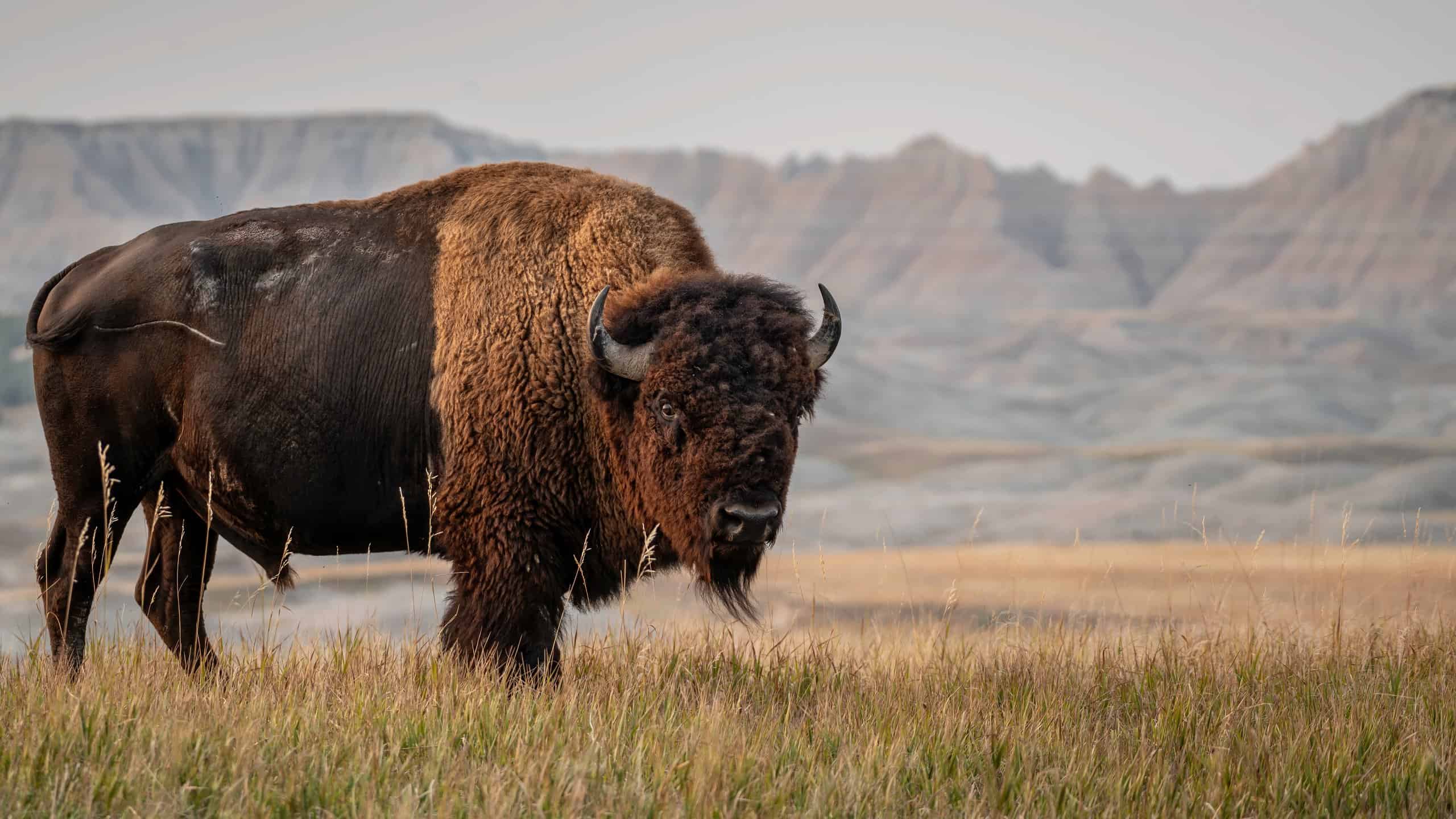
The bison is the largest animal in Wisconsin.
©Tim Malek/Shutterstock.com
For full descriptions of the seven largest animals in Wisconsin, click here. The largest fish in Wisconsin is the Lake Sturgeon; largest bird is the sandhill crane; largest snake is the bullsnake; largest amphibian is the mudpuppy (a type of salamander); and the largest insect is the Carolina wolf spider. All of these are somewhat dwarfed by the largest mammal in the state: the American bison. With their gigantic heads, massive horns, and shaggy fur, the bison is also the largest animal in North America.
Endangered
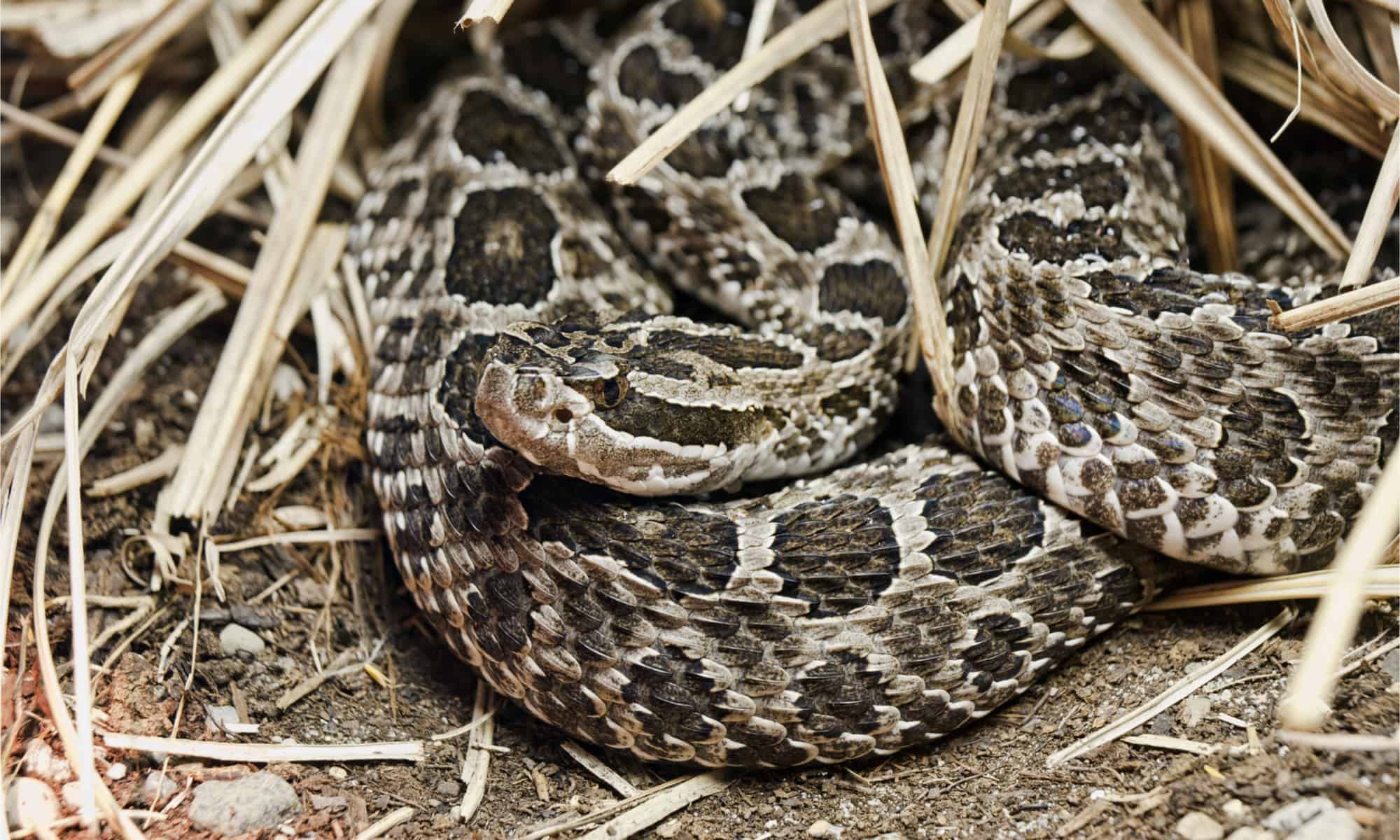
The massasauga was once almost extinct and is still suffering from habitat loss.
©DnDavis/Shutterstock.com
Wisconsin’s endangered animals include:
- Sheepnose – This animal with the weird name is a mussel that lives in freshwater rivers and streams. It’s on the endangered list due to habitat loss.
- Karner Blue Butterfly – Although this strange and beautiful butterfly has been endangered since 1992, it’s not extinct. Some zoos are working to increase the population of this rare butterfly by breeding them in captivity and releasing them.
- Eastern Massasauga – This endangered snake lives in the wetlands of Wisconsin. This snake was once at risk of becoming extinct because it was hunted as a pest. Now, though the population is increasing, it is still suffering from habitat loss.
- Rusty Patched Bumble Bee – This bee is listed as Critically Endangered because its population has decreased by 87 percent over the last two decades. This decrease in population puts it at risk of becoming extinct. Pesticide usage and habitat loss are two reasons for the decreasing numbers.
- Spectaclecase Mussel – Spectaclecases often grow larger than 9 inches in length and live in small clusters, distributed in freshwater rivers sporadically. While pollution is a huge cause for the decline of most spectaclecase populations, the invasive zebra mussel is also a primary concern.
- Regal Fritillary – This butterfly has unique and distinct markings on its wings, with a row of spots along the base. It needs prairies and other tall grasslands to feed and reproduce, which is why the Midwest is the primary region it inhabits.
Rarest
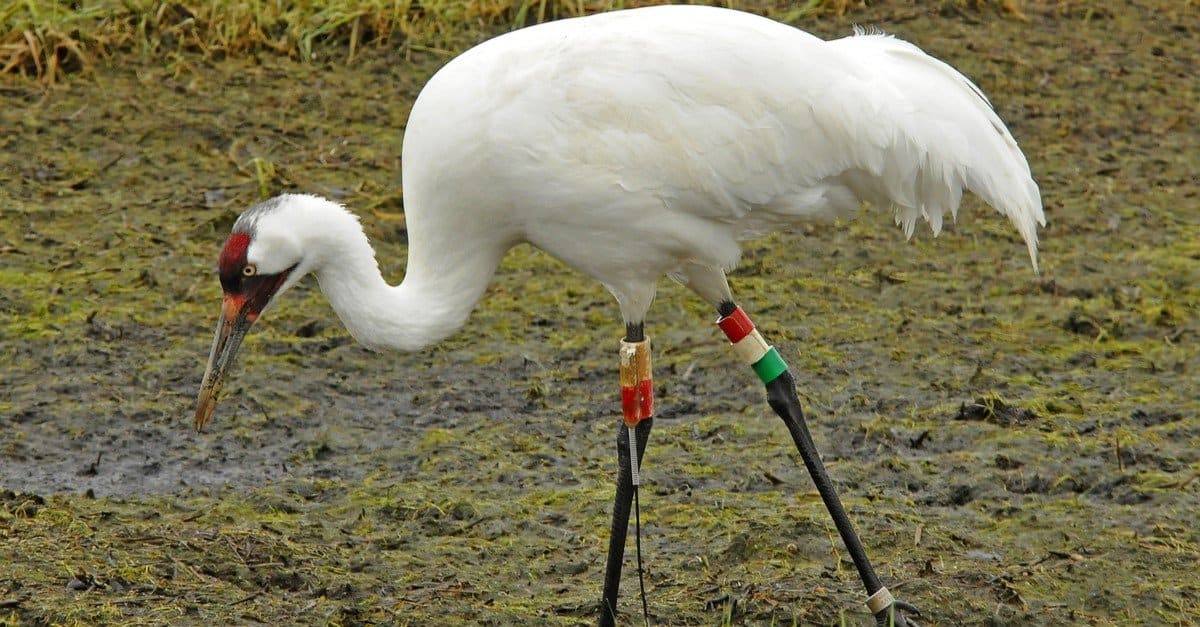
The whooping crane disappeared from Wisconsin for a while, but are now migrating back to nest.
©Brian A Wolf/Shutterstock.com
Whooping Crane – This endangered species disappeared from Wisconsin for several years. But young whooping cranes are now migrating to the state again along with groups of sandhill cranes. Biologists are seeing a slow increase in their population.
Officially declared endangered as early as 1967, whooping cranes are extremely rare in the wild. However, Wisconsin is a special place in that it is the first location where whooping cranes have nested naturally in over 100 years. This is largely credited to the Whooping Crane Eastern Partnership Reintroduction Project. This is a conservation effort dedicated to restoring the wild population of whooping cranes despite continued habitat loss and hunting that keep whooping crane populations at risk.
Flag
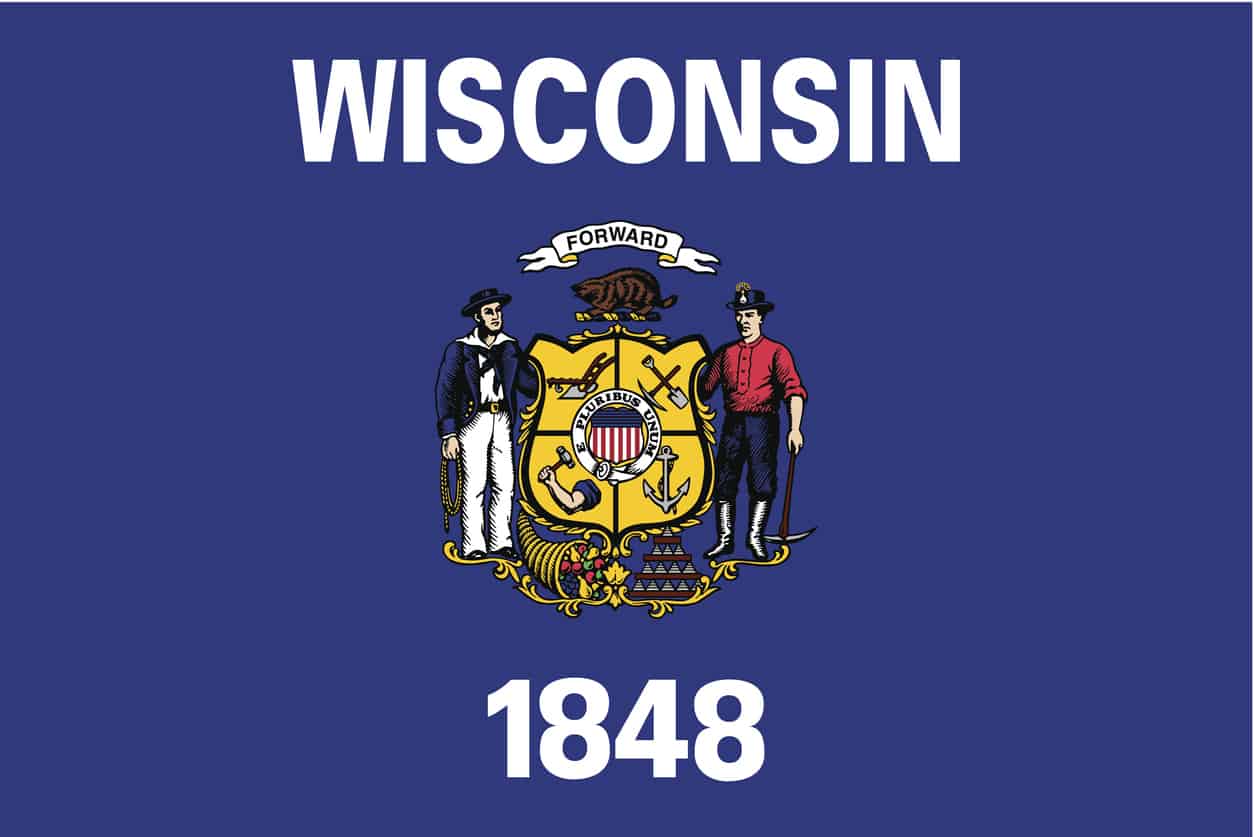
Wisconsin’s flag has the United State Coat of Arms in the center to demonstrate its loyalty to the country.
©iStock.com/Symbol Systems
The flag of Wisconsin consists of a dark blue field with a central coat of arms, the name of the state, and the date it was admitted into the Union, 1848. At the center of the Coat of Arms is the US Coat of Arms, which symbolizes Wisconsin’s loyalty to the country.
There’s a sailor and a miner on the flag, both of whom represent the kind of work that existed back in 1863 when the state’s first flag was designed. Within the shield are symbols of the several trades that also existed back in the day: the plow for agriculture, the anchor for navigation, the pick and shovel for mining, and the arm and hammer for manufacturing. There’s a badger, the state animal, above the shield, and it symbolizes the nickname given to miners in those days because they lived in mine shafts that looked like badger holes.
Below the shield, on the left side, is a cornucopia, representing abundance and prosperity. A pyramid of 13 ingots on the right stands for the 13 original colonies and mineral wealth.
State Seal
The Wisconsin state seal was finalized in 1881 when Wisconsin officially became a state. It incorporates the state’s coat of arms and 13 stars to represent the 13 original American colonies. The seal appears on the official state flag as well.
More Articles Related to Wisconsin
Read about:
- extinct animals that lived in Wisconsin.
- the breathtaking waterfalls in Wisconsin.
- the best Wisconsin lakes in Wisconsin.
- the longest biking trail in Wisconsin.
- the best national parks in Wisconsin.
- the most common roaches in Wisconsin.
- the best dog parks in Madison, Wisconsin.
- Discover the Coldest Place in Wisconsin
- Native trees to Wisconsin
- Discover the Largest Forest in Wisconsin (And What Lives Within it)
Wisconsinite Animals

Admiral Butterfly
Stunningly beautiful wings

Armyworm
They are so named because they "march" in armies of worms from one crop to another in search of food
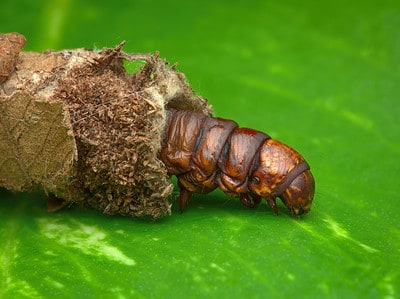
Bagworm Moth Caterpillar
They continually enlarge their protective cases

Beewolf wasp
They hunt bees

Black Witch Moth
Some folklore associate Black Witch Moths with bad luck (and even death!), while other associates them with good fortune.
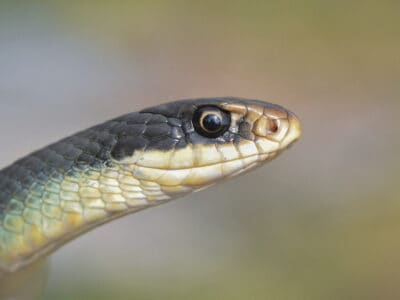
Blue Racer
Some blue racers have smooth scales that are solid electric blue while others are grayish or brownish.
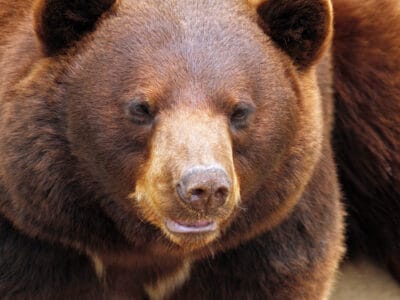
Cinnamon Bear
A newborn cinnamon bear weighs 1/2 pound -- about the same as a large apple.

Common Yellowthroat
The Common Yellowthroat stays close to the ground and uses stealth to survive!
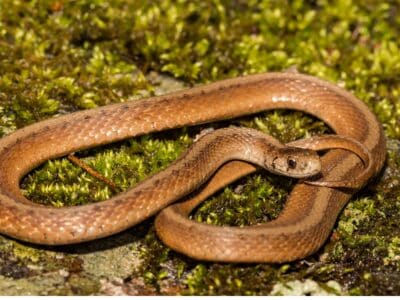
De Kay’s Brown Snake
They have specialized jaws for removing snails from shells.

Eastern Hognose Snake
Eastern hognose snakes are venomous, but only to frogs and toads.

Flea
Adult fleas can jump up to 7 inches in the air
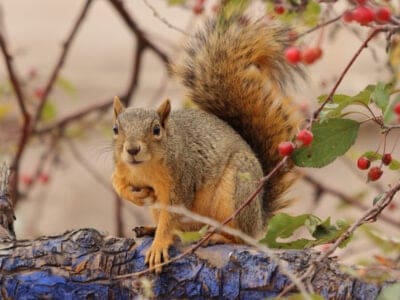
Fox Squirrel
Although it is a tree squirrel, it spends most of its time on the ground.
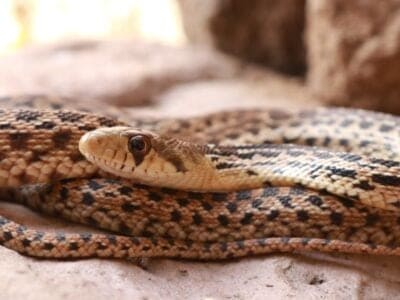
Gopher Snake
Gopher snakes can reach up to 9 feet long.

Groundhog (Woodchuck)
They whistle to each other to warn of approaching danger!

Kentucky Warbler
The Kentucky Warbler appears to wear bright yellow cat-eye glasses!

Massasauga
The name “Massasauga” comes from the Chippewa language, meaning “Great River Mouth”.

Mealybug
They have a symbiotic relationship with ants.

Miki
They can be trained to use the litter box like a cat!

Mockingbird
Mockingbirds are incredible mimics that can learn hundreds of songs!
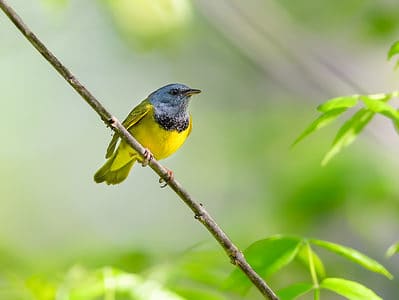
Mourning Warbler
The Mourning Warbler was named for its gray head, which resembles a mourning veil!

Nematode
Nematodes range in size from 1/10 of an inch to 28 feet long

Orb Weaver
Females are about four times the size of males

Owl
The owl can rotate its head some 270 degrees
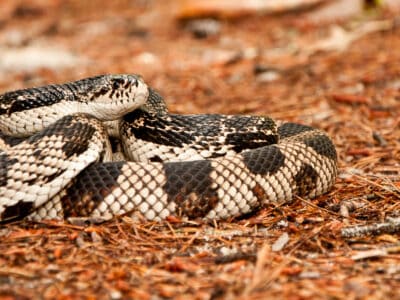
Pine Snake
Pine snakes bluff with the best, trying to scare you away.
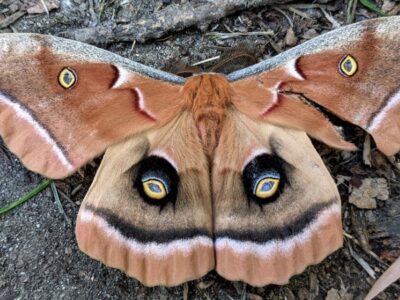
Polyphemus Moth
The Polyphemus moth doesn’t and can't eat, except when it's a caterpillar!
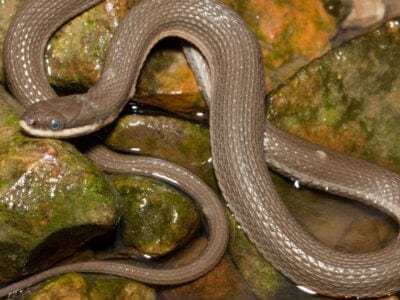
Queen Snake
Queen snakes have armor-like scales on the top of their head

Rat Snakes
Rat snakes are constrictors from the Colubridae family of snakes.

Red-Bellied Woodpecker
Red-Bellied Woodpeckers will often steal the nests of other birds.
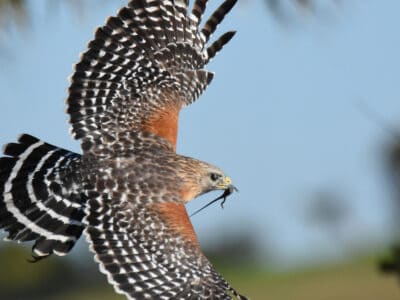
Red-Shouldered Hawk
Red-Shouldered Hawks reuse the same nesting area each year.

Rooster
Will mate with the entire flock!
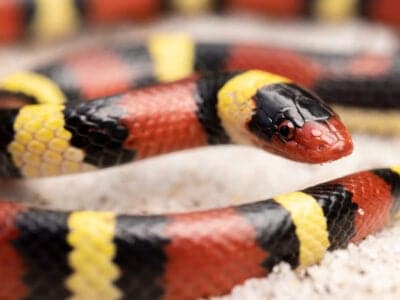
Scarlet Kingsnake
Scarlet kingsnake’s pattern is an example of Batesian mimicry.
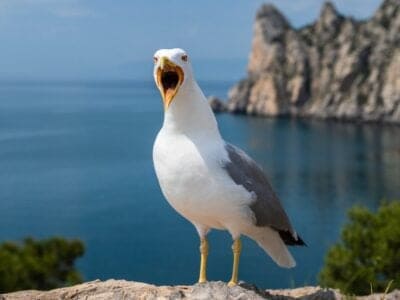
Seagull
Some gulls are capable of using tools

Smokybrown Cockroach
Has up to 45 eggs per egg case

Southern Black Racer
These snakes live underground, beneath piles of leaf litter or in thickets, and they are expert swimmers.

Tree Cricket
They make music with their wings
Wisconsinite Animals List
- Admiral Butterfly
- Armyworm
- Bagworm Moth Caterpillar
- Beewolf wasp
- Black Witch Moth
- Blue Racer
- Cinnamon Bear
- Common Yellowthroat
- De Kay’s Brown Snake
- Eastern Hognose Snake
- Flea
- Fox Squirrel
- Gopher Snake
- Groundhog (Woodchuck)
- Kentucky Warbler
- Massasauga
- Mealybug
- Miki
- Milk Snake
- Mockingbird
- Mourning Warbler
- Nematode
- Orb Weaver
- Owl
- Pine Snake
- Polyphemus Moth
- Queen Snake
- Rat Snakes
- Red-Bellied Woodpecker
- Red-Shouldered Hawk
- Rooster
- Scarlet Kingsnake
- Seagull
- Smokybrown Cockroach
- Southeastern Blueberry Bee
- Southern Black Racer
- Swallowtail Butterfly
- Tree Cricket
- Yellowish Cuckoo Bumblebee (formerly Fernald’s Cuckoo Bumblebee)
Animals in Wisconsin FAQs (Frequently Asked Questions)
What kind of animals live in Wisconsin?
One of the animals living in Wisconsin is known as the American marten. A marten’s small ears and long body make this mammal look like a strange cross between a weasel and a mink. Other mammals in Wisconsin include black bear, white-tailed deer, badgers, red foxes, and snowshoe rabbits. Rodents including mice, voles and moles live in the state.
There are snowy owls that migrate south from above the Arctic Circle to spend the winter in Wisconsin. They are rare predators of anything but lemmings. However, they sometimes capture other rodents such as mice or voles. Other birds include the chestnut-sided warbler, the pileated woodpecker and bobolink among many others.
Wild snakes living in Wisconsin include the timber rattlesnake, the eastern massasauga, the western ribbon snake, and the queen snake. The green treefrog, American bullfrog, the spring peeper and the northern leopard frog are some amphibians that make their home in this northern central state.
What is the most dangerous animal in Wisconsin?
The most dangerous animals in Wisconsin are the white-tailed deer, deer ticks, eastern massasauga, timber rattlesnake, and the black bear.
What animals are unique to Wisconsin?
The hoary bat is unique in that it claims the title as Wisconsin’s biggest bat. This strange nocturnal flier is almost six inches long with a 15.5-inch wingspan. One of Wisconsin’s unique rodents is the Woodland Jumping Mouse. This mouse can jump a distance of over 9 feet using its strong legs, feet, and tail. The northern flying squirrel is one of Wisconsin’s most unique (some say weird) animals because of its ability to glide from tree to tree. This squirrel uses folds of skin attached to its wrists and ankles to ‘fly.’
What’s the biggest animal in Wisconsin?
A moose is the biggest animal in Wisconsin. A moose can grow to a height of 6.5 feet and weigh 1,800 pounds.
What spiders are in Wisconsin?
Wisconsin is home to many spider species including the wetland giant wolf spider, orb weavers, jumping spiders crab spiders, and also the northern black widow, which is known for its venomous bite.




